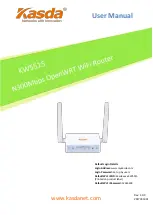
C
HAPTER
8
| AP Client Mode Wireless Configuration
Profile
– 91 –
■
802.11 Ad hoc:
A group of wireless devices connected as an
independent wireless LAN. Select “Ad hoc” to associate to a peer
computer.
◆
Power Saving Mode
— Only available when “Infrastructure” is
selected as the network type.
■
CAM (Constantly Awake Mode):
Power saving mode is disabled.
■
Power Saving Mode:
Enables the power save operation.
◆
Channel
— The radio channel used to communicate with wireless peers
in an ad hoc network. The channel has to be the same for all peer
computers. (Only available when “Ad hoc” is selected as the network
type.)
◆
11B Preamble Type
— Sets the length of the signal preamble that is
used at the start of a data transmission. Use a long preamble (192
microseconds) to ensure connection to all 802.11b devices. When set
to Auto, a short (96 microseconds) or long preamble will be used
depending on the capabilities of other ad hoc network devices. (Only
available when “Ad hoc” is selected as the network type.)
(Default: Auto)
◆
RTS Threshold
— Sets the packet size threshold at which a Request to
Send (RTS) signal must be sent to a receiving station prior to the
sending station starting communications. The access point sends RTS
frames to a receiving station to negotiate the sending of a data frame.
After receiving an RTS frame, the station sends a CTS (clear to send)
frame to notify the sending station that it can start sending data. If the
RTS threshold is set to 0, the access point always sends RTS signals. If
set to 2347, the access point never sends RTS signals. If set to any
other value, and the packet size equals or exceeds the RTS threshold,
the RTS/CTS (Request to Send / Clear to Send) mechanism will be
enabled. The access points contending for the medium may not be
aware of each other. The RTS/CTS mechanism can solve this “Hidden
Node Problem.” (Range: 0-2347 bytes)
◆
Fragment Threshold
— Configures the minimum packet size that can
be fragmented when passing through the access point. Fragmentation
of the PDUs (Package Data Unit) can increase the reliability of
transmissions because it increases the probability of a successful
transmission due to smaller frame size. If there is significant
interference present, or collisions due to high network utilization, try
setting the fragment size to send smaller fragments. This will speed up
the retransmission of smaller frames. However, it is more efficient to
set the fragment size larger if very little or no interference is present
because it requires overhead to send multiple frames. (Range: 256-
2346 bytes; Default: 2346 bytes)
Содержание SMCWBR11S-N
Страница 1: ...BarricadeTM N 150Mbps Wireless N Mini Broadband Router SMCWBR11S N USER GUIDE...
Страница 137: ...SMCWBR11S N...
















































